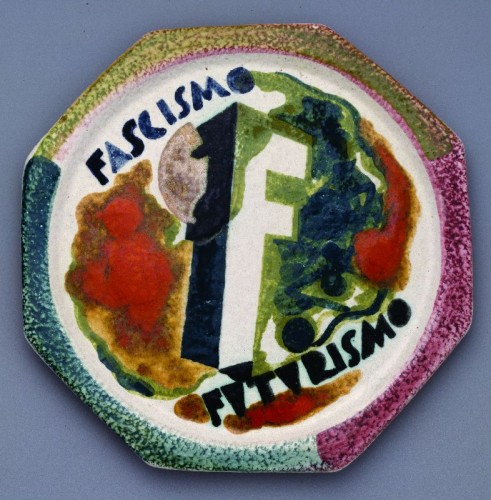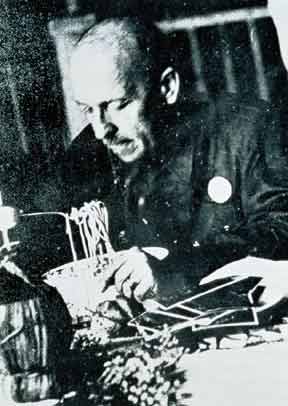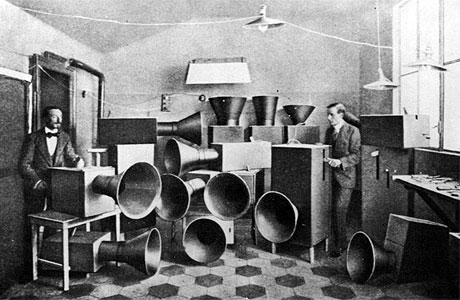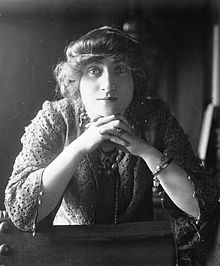
Giovanni Acquaviva: Facismo/Futurismo Plate from The Life of Marinetti Dinner Service 1939. Wolfsonian Musuem, Miami, Fla.
To some, mixing art and politics is like mixing oil and water. In reality it is more like mixing oil and vinegar. But where’s the salad?
The dangers are (one) political aesthetics and (two) artistic politics.
Examples of the first danger are when, in olden times, Greenbergian formalists froze out political art, the better to promote capitalism around the world; and nowadays, in more enlightened times, when poststructuralists use aesthetics to destroy their academic rivals.
An example of the second danger — artistic politics — is Futurism. Poet and provocateur F.T. Marinetti, the founder of Futurism, was a Fascist war–monger and a passionate supporter of Mussolini.
In “Italian Futurism, 1909-1944: Reconstructing the Universe” (to Sept. 1), the Guggenheim bravely surveys all of Italian Futurism, not just the so-called Heroic Period we know so well from the Museum of Modern Art. For better or worse, we get to see the Second Futurism, which transpired during Marinetti’s full-fledged support of his friend Il Duce — who like Franco in Spain and Marshal Pétain of Vichy France was in bed with Adolph Hitler. By 1938, Mussolini was also a rabid anti-Semite. Marinetti was not.
I am happy to report that unexpectedly, the art historians and the art critics have been right all along.
Futurism after World War I, when Marinetti led his brigade into the hands of the Fascists, had a serious decline. Even the much awaited New York debut of Benedetta Marinetti’s wan post-office mural at the Guggenheim is a disappointment. There is a certain frisson in spotting Balla’s overtly Fascist dinner set —– the second time for me, for I have seen it before at the Wolfsonian Collection of Decorative and Propaganda Art, in Miami Beach. But it is indeed the nastiest dinnerware I have ever seen. Would you eat Marinetti’s “divorced eggs” (from his Futurist Cookbook) off Balla’s Futurist/Fascist plate?
Marinetti, the manic producer of manifestos, to his credit was anti-farinaceous. In his Manifesto of Cuisine he claimed pasta was making Italian men weak. He was ahead of his time in being anti–carb. He was the Dr. Atkins of Milan.

The Ant-Pasta Marinetti supposedly caught eating spaghetti, 1930. Story here.
Marinetti Was Against Spaghetti
We once cooked a Futurist dinner for art critic Lawrence Alloway and his wife, the painter Sylvia Sleigh. They were not amused.
If I remember correctly, we started with “divorced eggs” — minced hard-cooked eggs divided into adjacent mounds of yellow and white. Or was it the whites mince surrounding the yolk mince? And then we had:
Chicken Fiat: A chicken is roasted with a handful of ball bearings inside. “When the flesh has fully absorbed the flavor of the mild steel balls, the chicken is served with a garnish of whipped cream.”
Simultaneous Ice-Cream: Vanilla dairy cream and little squares of raw onion frozen together.
Listen Up!
So the big question here is what do you do if you admire certain aspects of Futurism but loathe the politics. If you admire the iconoclasm, the valorization of speed, motion, and 20th-century mechanization? The celebration of the locomotive, the automobile and then, in the so-called Second Futurism after WWI, the airplane, but not the desire for war? If you admire, the invention of Performance Art, Noise Music, and Radio Art? If you admire the daring invention of Mixed Media, Trans Media, and Fashion Art? If you admire Futurism’s emotionalism in opposition to the café cool of Cubism?
We shouldn’t throw away the babies floating in the toxic Futurist bath. These “babies” are our grandparents. Without Futurism there would be no Dada. Without Dada, no Surrealism. Without Surrealism, no Abstract Expressionism. Without Dada, no John Cage, no Pop….
Another thing we can do to save Futurism is to pull back and look at International Futurism.
We now deserve an exhibition of same. Certainly Marinetti seeded International Futurism, but art history zigzags, intertwines, and braids. For instance, the on-the-ground instigator of Russian Futurism was the remarkable, Ukrainian-born David Burliuk, who was joined by, among others, my favorite Russian poet, Vladimir Mayakovsky, a full-fledged Bolshevik. Burliuk, as I have pointed out before, also was the instigator of Japanese Futurism!
Furthermore, in 1925 Marinetti went on a tour of South America — Rio, São Paulo, Montevideo, and Buenos Aires. His one-man Futurist poetry performances were roundly booed, which, as in Italy, he no doubt instigated and provoked by his in-your-face declamatory style. Some accused him of merely trying to gain support for his fat friend Mussolini. Screaming at people and shouting “nonsense” syllables is a strange way to promote a cause. Nevertheless, in Brazil he is usually credited as a key inspiration for Modernismo, their modern art.
Their were Futurist poets in the Soviet Union, Czechoslovakia, Poland, Slovenia, Portugal, Ukraine, England, and Lithuania.
AND…..
Although Marinetti is usually considered antifeminist, there were female Futurists. Perhaps he wasn’t so much antifeminist as anti-housewife. Not only was his wife, Benedetta, a Futurist but so was the fascinating Parisian Valentine de Saint-Point, grand-niece of French poet Alphonse de Lamartine. Saint-Point was an artist’s model for Rodin. But, more importantly, she was also a poet, painter, sculptor, playwright, choreographer, and journalist. She wrote two Futurist manifestos of her own in rebuttal to Marinetti’s sexism. Here’s a jolt from her Manifesto of a Futurist Woman (1912):
(((If you don’t like this, you should have your weakly sentimental head split open by an apache-dancing tramp with a pistol.)))
Humanity is mediocre. The majority of women are neither superior nor inferior to the majority of men. They are all equal. They all merit the same scorn…
It is absurd to divide humanity into men and women. It is composed only of femininity and masculinity. Every superman, every hero, no matter how epic, how much of a genius, or how powerful, is the prodigious expression of a race and an epoch only because he is composed at once of feminine and masculine elements, of femininity and masculinity: that is, a complete being.
Any exclusively virile individual is just a brute animal; any exclusively feminine individual is only a female.
The main point of her Manifesto of Lust (1914) is that lust, even for women, is “the quest of the flesh for the unknown.”
In 1918, she moved to Morocco, converted to Islam, and delved into North African politics. Later in life, destitute, she practiced dowsing and acupuncture. She died in Cairo in 1953, a kind of Muslim saint. Her tombstone described her as “a zealot of divine light.”
But Why Were Italians So Attracted to Mussolini?
Il Duce was at least as popular in Italy as Hitler was in Germany. Great Britain had Oswald Mosley, and the U.S. had Huey Long and Father Coughlin, favorites of architect Philip Johnson during his youthful pro-Nazi period. And there were huge meetings of the German Bund, out on Long Island in Yaphank at Camp Siegfried. This German-American “culture camp” was eventually closed down by the F.B.I. because when the Nazi threat abroad became more apparent, the locals accused the Bundists of espionage.
Why was the U.S. finally immune to Fascism? I think because we had FDR tinkering with the economy and initiating the WPA, whereas in Germany and Italy they had parades. They had scapegoats. They had thousands upon thousands of thugs in military costumes.
Recently I came across Christopher Duggan’s Fascist Voices: An Intimate History of Mussolini’s Italy (Oxford University Press). Duggan has recounted and analyzed the letters Mussolini received from his fellow Italians, an average of 1500 a day. There can be no doubt that the deluded Italians, like their Nazi allies, went in for hero worship in a big way, even when their idol wasn’t much of a hero. Not all the letters are suck-up pleas for intercession. The most disgusting ones are pure adoration.
I can remember older Italian friends saying Mussolini may have been a disgusting tyrant and a gangster like Stalin, but at least he made the trains run on time. We think the siren call of totalitarianism is the fear of disorder, peppered sometimes with the embarrassment of defeat. Weak minds yearn for a father figure, who through strong will, strict enforcement, and punishment will finally set things right. Artists and writers are not necessarily immune.
There is no doubt in my mind that Marinetti was a genius, but, alas, a kind of permanent adolescent. An aristocrat with his head up a certain part of his anatomy.

Bendedetta (Marinetti): Synthesis of Communications, 1934. Palermo Post Office, now at the Guggenheim as part of Italian Futurism.
How to Tackle the Exhibition
The “good” stuff, sanctioned by art history, you already know.
Alas, the paintings in the Guggenheim, even the famous ones, up close in real life now look timid. These (if you excuse the expression) warhorses, these modernist machines (“machines,” as in academic art), are dull.
Is it the lighting? Is it the vortex space and the slanted floors? The Guggenheim long ago solved the curved-bay problem presented by Mr. Wright, but climbing from bottom up, round and round — which you must do for sake of chronology – has a draining effect.
But even if you elevator to the top and walk downhill, seeing the show backwards, you still cannot avoid the infamous MoMA Syndrome.
Unlike the tin saints and plaster statues “aurafied” by praying grandmothers, paintings seen by millions and known by many more through reproductions and now jpgs suffer hugely from “aura depletion.” They have been sucked dry – another technical term – of their je ne sais quoi.
So what else is wrong with the exhibition? A little video fails to communicate what the poetry events/readings and the art performances and theater pieces were like. It does not communicate the outrageous inventiveness and the sound and fury that led directly to Dada.
And I was looking forward to Balla’s Fireworks, a dancerless ballet commissioned by the great Sergei Diaghilev. Alas, in spite of a ministadium tricked up with colored lights, all you really get is Stravinsky’s music and a tiny screen off to the side. In itself, the 2010 digital recreation is swell but, as presented, swell only in a dollhouse way.
Fortunately, I found my dog-eared copy of Michael Kirby’s Futurist Performance, E. P. Dutton (1971). Kirby also wrote the book on Happenings. When I was teaching, I used both.
Kirby does no better than most with the Futurist conundrum, recommending that we once again separate politics and art. Fortunately, when he gets going with his skillfully collected material, I am even more convinced that the real contribution of Futurism was its poetry and theater, not the Baroque Cubism of the whirling paintings or the bland Art Deco of the Second Wave.
Futurist performance started with the wacky poetry readings (serates or evenings) that Marinetti instigated — chanting, shouting, assaulting the audience. And these evolved into what the grand mischief-maker called sintesi [synthesis(es)]. The sintesi are amazing. Most were short, like theatrical koans. But unlike various skit-oriented comedies we know from past TV (Laugh-In, Monty Python’s Flying Circus, even the work of the inspired absurdist Ernie Kovacs), they were vicious and transcendent at once.
Some have no sound. Some have no light or too much light. Some have no actors. In one you see only the actors’ feet. As Kirby points out, without Futurism there would be no Pirandello (who knew Futurism) or later, Ionesco. From a contemporary viewpoint, without Futurist poetry slams and theater there would be no Performance Art. Here is an example of a Futurist play, Lights by Francesco Canguillo:
Raised curtain.—Neutral stage.—Stage and auditorium completely in DARKNESS for 3 BLACK minutes.
Voices of the PUBLIC
1. (person) —– Lights!
2. (persons) —- Lights!
4. —————— Lights!
20. —————- Lights!! Lights!!
50. —————- Lights!! Lights!! Lights!! Lights!
(Contagious)
THE ENTIRE THEATER
LIGHTS ! ! ! ! !
( The obsession for light must be provoked — so that it becomes wild, crazy – by various actors scattered in the auditorium, who excite the spectators and encourage their shouting.)
The stage and auditorium are illuminated in an EXAGGERATED way.
At the same moment, the curtain slowly falls.
Giving proper weight to poetry and performance in a visual-art venue is obviously difficult. It usually means, as at the Guggenheim, books and posters in glass cases and a few paltry videos. Why wasn’t a ticketed performance or two added during the run of the show? The Guggenheim is stuck in the conservative, market-oriented, art-history hierarchy that puts paintings, no matter how awful, at the top. In this installation, the awkward truth about Italian Futurism is studiously avoided. The parole in libertà (“words-in-freedom”) and performance are the best and most important contributions of the Futurist folly.
Do You Have a Tolerance for Illustration?
Your reaction to Futurist paintings will largely be determined by your tolerance for illustration. Even the extremely talented Balla, for all the Futurist gabbing about speed and putting the viewer in the center of the painting, rarely did more than illustrate these principles. It took many years to arrive at Action Painting, which embodied rather than illustrated the kinetic and really put the viewer at stage center. Futurism is the unacknowledged link between the Baroque and Action Painting. If the most important thing in the world is crossing a river, it doesn’t matter what the bridge looks like.
On the other hand, you could also say that Futurism was a poetry movement: Marinetti’s. It toddled along after World War I by embracing aero-views, absurd cuisine, design, and the decorative arts. Futurism died in 1944 — along with Marinetti, its ringleader and pitchman. Too bad he wasn’t able to see how World War II turned out, Mussolini and his mistress shot dead by partisans in 1945 and hung upside down in Milan’s Piazzale Loreto.
Can we learn something about art by studying Futurism? Yes. Can we forgive the adherence to Fascism? No.
FOR AN AUTOMAtIC ARTOPIA ALERT FOR EACH NEW INSTALLMENT PLEASE CONTACTperreault@aol.com
John Perreault is on Facebook, specializing in neo-modern residential architecture. Links here for John Perreault’s website & John Perreault’s art.





